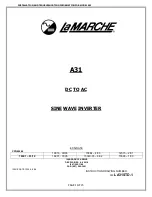
Operation 21
CG635 Synthesized Clock Generator
The CG635 will integrate phase steps in the main display until the phase reaches ±720°,
at which point it will wrap the phase back to 0°. For example, if the current phase is 700°,
and the user steps the phase 90°, the CG635 will display 70°.
The phase resolution of the CG635 is frequency dependent and is summarized in
Table 12.
Table 12: Phase Resolution versus Frequency
Frequency Phase
Resolution
200 MHz < f
2.05 GHz
1°
20 MHz < f
200 MHz
0.1°
2 MHz < f
20 MHz
0.01°
200 kHz < f
2 MHz
0.001°
20 kHz < f
200 kHz
0.0001°
2 kHz < f
20 kHz
0.00001°
200 Hz < f
2 kHz
0.000001°
20 Hz < f
200 Hz
0.0000001°
2 Hz < f
20 Hz
0.00000001°
1 µHz
f
2 Hz
0.000000001°
If the user tries to enter a phase with more resolution than permitted, the CG635 will
truncate the result to the appropriate resolution.
When the user changes frequency, the CG635 will automatically reset the phase to 0°,
and truncate the phase step size to the resolution allowed at the new frequency. For
example, let the current phase and phase step size be 123.456° and 0.0001°, respectively.
If the user changes the frequency to 100 MHz, the CG635 will change the phase and
phase step sizes to 0.0° and 0.1°.
The user can define the current phase to be zero degrees by accessing the secondary
function REL
ș
= 0°. The secondary function,
ș
+ 90°, is also available for advancing the
phase by 90°.
For frequencies greater than or equal to 1 Hz, the CG635 adjusts phase by increasing or
decreasing the frequency for a short interval of time to advance or retard the phase by the
desired amount. This is the case even when the phase step is 360°. Advancing phase by
360° results in one extra cycle being inserted over the time period of the phase shift.
Similarly, retarding phase by 360° results in one less cycle being inserted over the time
period of the phase shift.
In most cases, phase shifts take less than 150 ms to complete. At low frequencies,
however, backward phase shifts can take significantly longer. This is simply due to the
fact that the frequency can not be shifted below 0 Hz. Therefore, a backwards phase shift
of 360° at 1 Hz takes a minimum of one second to complete. Arming circuitry in the
CG635 may add an additional 0.5 seconds to that time.
For frequencies less than 1 Hz, the CG635 does “instantaneous” phase shifts using DDS
techniques. In contrast to phase shifts at frequencies above 1 Hz, a 360° phase shift at
















































